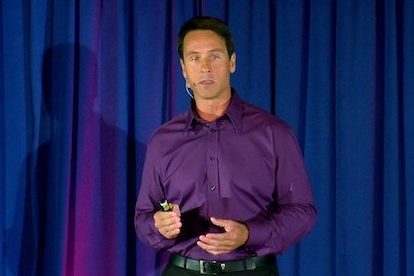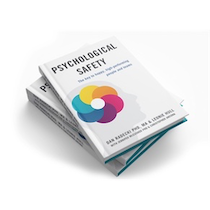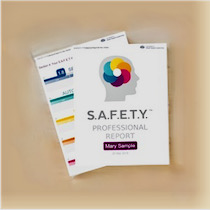Once Amy Edmondson published her book The Fearless Organization on psychological safety1 in 2018, many grabbed onto the concept and ran with it. Some analyzed the importance of psychological safety to one’s health and well-being. Some considered ways to better understand the triggers people face, their need for psychological safety, and how such understanding can positively impact efficiency and creativity. These are noble and necessary goals of psychological safety. This is knowledge that could benefit society by making it more fair, making us more understanding of others, and helping people creatively and effectively work together by avoiding misunderstandings. Still, an entire piece of the story of being human has been neglected while society seeks a pinnacle of psychological safety.
As we endure a one-sided psychological safety education – with an over emphasis on things like safe spaces and trigger warnings in our everyday lives – we also face the unwinding of honored rights. An abundance of psychological safety nets have created threats to our constitutional right to free speech. These threats are now evident with the regular repression of university course material, the authoritarian control over the actions, course material and speech of teachers, the removal of historical statues, and the outright cancellation of people who do not hold the majority view2,3,4.
Let me be clear, safe places undeniably have purpose. Though the official term dates back to around the 1960’s, safe spaces have been used for centuries or longer. They were first modernized for women in abusive relationships and for the LGBT community (whose lifestyles were literally illegal due to sodomy laws5). Safe places gave individuals a place to meet like-minded or like-experienced people, so they could rebuild or establish a sense of self-esteem. They could talk openly, get support, and make friends who could understand them. M.R. Kenney explained, “A safe place was where people could find practical resistance to political and social repression.”6 But if you think about safe places and safe spaces by that definition, the concept goes back in time much, much further.
The National Woman Suffrage Association was founded in 1869 to fight for a universal-suffrage amendment to the U.S. Constitution. For decades, suffragettes met in secret, safe places. Long before that, many of the forefathers of the United States were Freemasons, meeting in private, discussing the beliefs and ideals that were ultimately foundational ideas of the United States Constitution7. Let’s go back even further. Before the United States even existed, many of the ideas that were foundational to the thinking of our forefathers’ ideas were repressed because they were in direct opposition to the rules of the monarchies. So, one could say that the ideas that led to the creation of the United States were only able to be realized because of safe spaces and safe places. Religious repression prevailed in most of our recorded history, while oppressed people worshiped in secret together. Safe places are not a new concept; we could keep going back through history and in every period, we would find people gathering in private, seeking psychological safety with their peers.
But as soon as we see safe places, complete with an abundance of trigger warnings, applied at the broader level that psychological safety educators and the masses call for today, things get messy. Do terrorist organizations consider their meetings “safe spaces” for their ideas? If you look at a “safe space” as reasonably defined above, they are places that leverage “in-group bias” or the “trust trigger” in order to both create unity and potentially start large change processes in a cultural or political arena. This unavoidably pushes other people’s buttons – maybe fairness, or autonomy, or security.
We must remember that Psychological SAFETY can as easily be used as a weapon as it can a tool. So, inclusion of trigger warnings, repression of speech and ideas, and the forced use or forced omission of language for psychological safety’s sake frequently do more damage to a society than good. Psychological safety is NOT a right, and the belief that it is has been increasingly causing problems and creating ideologies that are not fully connected to the science nor the realities of life.
Today, more and more people in positions of corporate, academic and legislative authority hold the belief that the younger generations are vulnerable and need to be protected from potentially triggering material. They are convinced about the power of statues and pictures to objectively inflict emotional violence and to oppress. They teach that words and images are all-powerful in constructing reality … And therefore these things can lead to the feeling of being unsafe and must be avoided at any cost. While the root of their ideas about words and statues has some truth, it is not the whole truth. And when taken too far, is a perverted truth that neglects the unavoidable realities of life. Young adults are being shielded from the realities of history, cancer, war, inequalities, abuse, suffering, and death. In reality, humans can only prepare for the bigger tragedies of life by learning to survive and thrive through their comparatively smaller counterparts. It is these smaller upsets that prepare us by building and fortifying our resilience. The fact is, we can neither hide from nor avoid the realities of life. Instead, the only genuinely productive option for us, as human beings, is to build resilience through exposure and then adapt. That is in alignment with our human nature. That is our real superpower.
To show how this wrong-minded idea has pervaded our modern society, let’s take the example of The Little Mermaid. The Disney version ends with the little mermaid living happily ever after with her prince. However, the original version written by Hans Christian Anderson has the prince marry a princess from another kingdom, leaving the little mermaid to die without a soul. To save her own life, the little mermaid has one last chance where she must kill the prince before the sun rises. She refuses and instead throws herself into the sea to die. Luckily for her, she is given one more chance. She is allowed to wander the world for 300 years performing good deeds for humans with the chance to regain a soul7. The original version lacks the Disney picture-perfect happy ending, but it does better align with the character-building failures and tragedies that people face in real life.
For me, the original story resonates much more than the Disney “feel good” version. I lost my first love, the woman I planned to marry, to another man. I have not talked with her in person in decades. That is reality – and no talk of psychological safety as a shield could protect me from that reality. Now, maybe it was possible for me to have convinced her to marry me. What if I had used the concepts of the triggers of psychological safety as a tool to pressure or convince her that she had to marry me? I didn’t have to respect her choice. I could have appealed to her fairness trigger. Partners use guilt to keep their significant others regularly. Maybe I could have employed her esteem trigger by making her grandiose promises – or alternately – by cutting her down so that she would just accept that I was the best she could expect. I could have made her feel doubt by telling her bad things about her future husband. But I didn’t do those things, and facing the truth eventually made me a more resilient man. Facing the truth led me to a more interesting life story than I would have otherwise had. It allowed me to learn and to adapt. We need both the pain and joy of life to survive, to grow, and to build our life story. No matter how much one espouses psychological safety as a panacea, someone will inevitably suffer. Besides, if I had utilized my first love’s triggers to convince her to stay with me, would you find my actions correct, ethical, or good? I doubt it.
But people use our triggers like this all the time – even naturally. However, some see that kind of behavior as Machiavellian, remembering that his book, The Prince, was the first practical book about leadership. It was written based on actual evidence about how life truly is. What he found (without knowing it) was that the concepts we now label “psychological safety tools” were used as manipulation tools targeting a ruler’s own people. They were used to gain and maintain power. Sun Tzu described in The Art of War how these tools were used to trap their enemies so that they could destroy them. These tools were always leveraged as either weapons of war or to gain power.
So, as you can see, the concepts of psychological safety were not meant to be a shield from the world. It was not meant to act as a justification to hurt others because a group does not agree with them. It was also not meant as a right, a rule book, or an obligation. Many of the ways it is being used today only serve as justification to move the feeling of repression from one group to another. This is nothing new, as evidenced by Machiavelli’s or Sun Tzu’s awareness of its power hundreds of years ago.
The actual benefit that the ideas of psychological safety provide is an education about how and why to improve conditions for yourself and others – if you so choose. This can either start with you recognizing your own mental traps that prevent you from growth or working with willing others to support the recognition of their own mental traps. Yes, as I’ve shown, this knowledge can also be used to manipulate others – and make no mistake, it IS used to manipulate others. This can manifest in workplace dysfunction if an employer boss gives an elevated title in lieu of a salary increase. It can manifest as a political operative who uses these skills to prevent their competition from gaining status through false information. It can manifest as emboldened protestors who use psychological safety concepts to prevent a person they disagree with from being heard. This is the unfortunate reality of what the tools of psychological safety can offer to our human interactions – and it cannot be prevented.
Although we cannot prevent any of these uses from pervading the human social environment, we can know the facts and learn about ourselves such that we can grow, adapt and build our own resilience through a combination of the knowledge of psychological safety, experience and self-reflection. This is our superpower. Because the use of the concepts of psychological safety will be used by some to manipulate others in order to gain power and destroy opposition, building our superpower is critical to thriving in today’s world. With both our superpower and the knowledge of psychological safety, we can benefit others, our company, our teams and ourselves, but if we fall prey to our own triggers and use psychological safety as a shield from reality by forcing our sensitivities to be respected by others instead of allowing the full interactions with others to strengthen us, we will fail to thrive. We are not fragile. We are not brittle. We have evolved to handle and adapt to the harshest circumstances. That is what makes us great, and why when challenges arise, it is important that our pursuit for psychological safety doesn’t rob us of our potential to grow and build resilience.
- Edmondson, Amy C. The Fearless Organization: Creating Psychological Safety in the Workplace for Learning, Innovation, and Growth. Hoboken, NJ: John Wiley & Sons, 2018.
- https://bariweiss.substack.com/p/my-university-sacrificed-ideas-for?s=r
- https://www.washingtonpost.com/local/native-american-professor-resigns-over-disputed-lecture-series/2017/10/30/ad156ebe-bd8c-11e7-959c-fe2b598d8c00_story.html
- https://www.theatlantic.com/magazine/archive/2015/09/the-coddling-of-the-american-mind/399356/
- https://www.vox.com/2016/7/5/11949258/safe-spaces-explained
- Kenney, M. R. (2001). Mapping gay L.A.: The intersection of place and politics. Temple University Press.
- https://www.usnews.com/opinion/articles/2009/09/14/masons-and-the-making-of-america
- Andersen, H. C. (1883). The little mermaid. Frederick Warne & Co.










